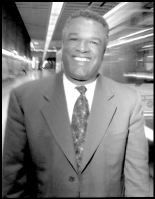AT LEAST IT WASN’T RAINING
In the middle of strip-mall hell, on a patch of grass outside the Overlake Park and Ride lot in Redmond, about 50 protesters gathered for the Direct Action Network’s first major action since setting local, national, and international politics on its ear during the World Trade Organization’s Seattle meeting.
On November 30, DAN had eschewed the tactics of more traditional groups, like labor’s big march, and instead mobilized thousands to blockade the Convention Center with the express purpose of shutting the WTO down; they succeeded beyond their wildest expectations, and took the city—and the world—by surprise.
In the heady weeks that followed, DAN scouted around for a new rallying point and in January declared it would celebrate the anniversary of Seattle’s 1919 general strike by shutting down Microsoft.
But the Microsoft protest was scaled back from blockade to street theater when labor withdrew its support. DAN’s curly-haired David Solnit, a key organizer of the protest, promised, “We’re shutting [Microsoft] down with puppets and theater.” Solnit argued the power of the art would make up for the lack of numbers.
But when February 7 arrived, Solnit didn’t even have anyone to carry DAN’s giant puppet of Bill Gates, much less a coherent street-theater act. A puppeteer volunteered from among the assembled, and the group set off down the suburban sidewalk carrying colorful banners and anarchist black flags. One man played the saxophone, another pounded out a rhythm on a plastic tub, and most everyone chanted or sang.
About halfway to the Microsoft campus, the protesters had a showdown with three cops over marching in the streets. The police insisted the group stay on the sidewalk. A few ignored their orders, and the police nabbed David Call, an anarchist with a kerchief over his face and a glass pipe—allegedly “drug paraphernalia”—in his pocket. The protesters were furious over the bust. “Let him go!” they screamed from the sidewalk. Suddenly an ambulance and nine more squad cars tore onto the scene and out tumbled 24 robocops in heavy black body armor, some of who began loading projectile guns.
By this time, the media and the cops nearly outnumbered the protesters, and the demonstration evoked more the ennui of an absurdist play than the electrifying power of November 30.
Eventually Call was taken off to the King County Jail, and the protest continued. Despite the arrest, the demonstrators created a festive atmosphere after they arrived on the Microsoft campus: A revolutionary pep squad ran through their numbers, including a human pyramid; a banjo-playing Earth Firster named Desert Rat banged out a tuneful song, “Dancing on the ruins of multi.national corporations”; and numerous people made speeches. The protesters were having a good time while trying to change the world, but as their small numbers made painfully obvious, it ain’t going to be easy.
THAT DOESN’T MEAN people aren’t trying. Radicals and revolutionaries throughout Seattle recognize that if some of the energy of even a few hundred of the people who turned out to “shut down Seattle” could be directed toward ongoing, long-term local struggles, our city’s neat, quiet political life might get messy and noisy.
This effort is very much in its infancy, but after surveying it by interviewing over 30 of its participants, here are a few general observations. Seattle’s post-WTO movement is mostly made up of many small circles of friends working together in affinity groups. These leaderless, autonomous groups are bound together very loosely. “It’s all word of mouth,” comments DAN organizer Erika Kay. “We don’t necessarily even know how to get in touch with one another.” (DAN itself is just a network of affinity groups without a central core.) The movement favors direct action that challenges the hammerlock corporations have on our economic, political, and cultural lives. “The changes will be made by focusing directly on the corporations—not by going to government,” says UW sophomore Ingrid Chapman.
With its emphasis on bold action by in.dependent affinity groups, the movement embodies the spirit of anarchism. The affinity groups “come together when they need to. They are guerrilla-based. It is a lifestyle of collective actions, doing things that bring the group together and challenge the system. That’s what anarchism really means,” argues veteran organizer John Fox of the Seattle Displacement Coalition.
In general, however, the activists avoid political labels and ideological debates. “I don’t want to get pigeonholed,” explains DAN’s Kay, sounding a theme heard repeatedly. “I integrate many different philosophies. I’m constantly evolving.”
Most members of the movement are college educated and white. This lack of diversity is on many people’s minds, and possible solutions are being hotly debated.
And most no-to-WTO rowdies are young. “Historically it is the youth who fuel these movements. The old fogies either give up or go work for Microsoft—except for a few of us old, hardcore stick-in-the-muds,” laughs John Reese, an anarchist who has long been active in local environmental circles.
Veteran organizers differ sharply in their view of this movement’s prospects.
Cindy Domingo of the Northwest Labor and Employment Law Office isn’t sanguine. She notes that social movements have ebbs and flows. “Now comes the hard work after a really big flow like [November 30].” She’s not sure the post-WTO movement is up to it. “There is really a big schism between communities of color and the white left,” she notes. Domingo, who is Filipino American, believes, “The left will never have the power they need until a real multi.racial character is built.”
She also distrusts the methods of the movement. “People think if they can sustain the demonstrations, it will build, but I’m not sure.” She sees the movement’s anarchist style of organizing as lacking focus and discipline. She trusts more in a “centralized Marxist-Leninist approach to work.”
She’s not all gloom, however. “I think very highly of those young people,” she says. “That’s the hope for us—that there are still some young people who want to become activists.”
In contrast, Fox, a white activist who founded the Seattle Displacement Coalition in 1977, believes the movement is moving in the right direction. “It is really vital. It captures interest and attention.” He endorses the anarchist methods of “lots of little affinity groups trying to make change in this collectivist fashion.” Fox’s group wants to capture some of that energy and “recharge our own batteries.” He has ridden these waves before, last in the late 1980s when squats, building occupations, and “Operation Homestead” energized housing politics locally.
“When I look back it’s the experiences on the street which are the most rewarding,” says Fox. “It takes mass-based protests to raise hell and win any significant victories for poor people. It takes a climate of protest to free up resources. Let’s go back to the street—that’s where change comes from. And hell, it’s fun. And in the end if you aren’t having fun, you are not going to sustain anything.” The sustainability of the post-WTO movement is in the hands of the highly individual, committed activists at its core. A close-up look at three of them provides a clearer picture of how the local political landscape could be reshaped in the months ahead.
Jeff Perlstein and guerrilla media
Media matters to Jeff Perlstein. A sweet-talking 30-year-old from New Jersey with big, brown puppy-dog eyes and thick tousled hair, he has paid the bills by being a nanny in recent years, while passionately promoting “guerrilla media.”
He first became aware of the bias of “corporate media” when he protested against the Gulf War as a student at John Hopkins University in Baltimore. “The Gulf war was a low point in terms of media coverage. There was such thorough manipulation.” Protesters found it outrageous that a “free” press allowed itself to swallow Pentagon propaganda about “surgical strikes.” When the major news corporations docilely submitted to the Pentagon’s rules for covering the war, including being limited in their reporting to sites deemed suitable by the generals, “it clarified the struggle of media” for Perlstein and many others.
A revolutionary movement for social change has to tell its own stories; it can’t rely on the mainstream media, whose ultimate purpose is to make a buck by selling soap, Perlstein believes. That’s why Perlstein wants to create the Independent Media Center, a “people’s newsroom” that he hopes will become a cornerstone in “the building blocks of a new society.”
Perlstein wants to arm activists with video cameras, tape recorders, and notebooks, and help them create their own documentaries, Web sites, radio shows, and newspapers. That’s exactly what the IMC did during WTO week. Given seed money from an ex-Microsoftie, Perlstein and his friends rented and renovated a space in the Glenn Hotel on Third Avenue (a space they may not be able to hold on to). From there they produced a daily newsletter called The Blind Spot, their Web site www.indymedia.org, and a videotape, Showdown in Seattle, all of which shamelessly led cheers for the protesters.
Post-WTO, the Independent Media Center is asking itself, “what does this project want to be,” explains Perlstein. “Who is our audience? Whose story are we telling? What is the ideological foundation?”
Local lefty media outlets already exist: publications like Eat the State! and Washington Free Press, cable-access TV like Network X, and pirate radio stations like Radio Free Seattle. One vision of the IMC is to bring these smaller, already existing projects together, share an office space, and collaborate. Another goal is to spearhead a network of movement media, teaching activists all over the world how to set up their own media shops.
Perlstein’s ambition extends even beyond these difficult tasks. He also wants the IMC to be led by poor people of color, who would use the media resources to tell their own stories. Currently the IMC is mostly made up of people like Perlstein—college-educated, white countercultural types. How the hell is Perlstein planning to bridge the gap between new Asian immigrants in the Rainier Valley, Latinos in South Park, and the hippies at the IMC?
Perlstein has plans. “We need to have a significant number of people of color on our board, support events which are located in these communities, lend resources to people to put on their own events, and rework our mission statement.” And go through “anti.oppression, antiracist training”—this idea is frequently mentioned in the post-WTO movement, but no one interviewed had ever actually participated in such training.
Perlstein admits his plan “is hugely ambitious” but quickly adds, “It has to happen. It’s absolutely necessary if we are going to talk about a true movement for justice.”
If the IMC can carry out even one prong of their ambitious agenda, it will be a huge achievement. They have no funding, no permanent home, and no agreement on what to do next, but they have captured the attention and excitement of the post-WTO movement in a way that no other single project has.
Hop Hopkins: Getting down with the Brown
Revolutionary fire burns in Hop Hopkins’ veins. He fuels it with intense, serious exploration of his own soul. His entire skull, from the top of his shaved head down to his goatee, strains with the effort of expressing the thoughts that are tearing up his head. “Why ask for just a crumb?” he demands the listener to answer. “If you think about the impossible being possible then you can have it. Let’s get together as revolutionaries. Let’s talk about what revolution means to you.”
Hopkins, busted at the WTO on December 1, is a member of the Brown Collective, an affinity group of 10 people who came together during the demonstrations. They share the belief that “capitalism is a social ill” and that communities of color are not involved enough in protesting the excesses of the global economy. They plan on organizing in their own communities, but first are going through an agonizing process of confronting their own “isms”—internalized racism, sexism, classism, heterosexism, ageism, etc. In meetings on Sundays, which have lasted as long as seven hours, they dialogue. “Let’s just be honest. Let’s talk about what hurts.” He tilts his head back. “It hasn’t been easy.” Hopkins believes through a searing, thorough process of confronting all the bigotry and prejudice inside, the Brown Collective can become a pure, red-hot force for social change. “We have got to deal with that stuff primarily, otherwise it will, like cancerous cells, spread through our organizing.”
After the purification, Hopkins plans to take it to the streets—not demonstrating in the streets, but walking them, going door-to-door on Beacon Hill, in Delridge, and in the Central District, organizing house meetings. “You have to meet people where they are,” Hopkins argues. “You have to have meetings after work, provide childcare, a ride, and a hot meal. You can’t go in with a set agenda. [You have to] listen to people. That requires true caring.”
He compares his method for revolutionary change to his day job at POCAAN (People of Color Against AIDS Network), where the workers go into bathhouses and under bridges meeting people, listening to what they “think about unprotected sex” and urging them to use condoms.
Born as a “military brat” 29 years ago in a single-parent family, moving from town to town, living in trailer parks, on unpaved streets, as one of a few kids of color in his schools, Hopkins understood alienation from his earliest days. Of course, he didn’t know its name or what to do about it. He tried to figure it out. On Sunday mornings he had an entire routine of political self-education in front of the TV: Meet the Press, Tony Brown’s Journal, and Firing Line with William F. Buckley. He concluded he should join the army. Commissioned at Fort Lewis, he soon realized the army didn’t have a humanitarian mission, and he wasn’t going to change the world for the better through Uncle Sam’s military.
Hopkins doesn’t regret his military service because it keeps him real. “I am so against screaming at police officers. They believe they are defending life, liberty, and the pursuit of happiness. I ain’t interested in going to the Gap or McDonald’s and screaming at people. Why would you want to get with people who are screaming and yelling at you?! It’s not their fault they need a job.”
Hopkins feels the left is out of touch with ordinary people. “I always laugh when I hear ԧrassroots’ in progressive circles. We are so caught up in so much academia and technology. Most people don’t have e-mail. Let’s be real about it. I’ll take a survivor over a thinker any day.”
He wishes white activists would show the commitment to dealing with their own “isms” that they show to being thrown in jail. Until then, revolutionaries of color “will seek to create safe spaces within our own organizations. You can’t fake the funk. I’m done with the dialogue.” He is waiting to see real institutional changes in white progressives’ groups that result from having done the necessary but painful internal work.
While Hopkins is critical of the white left, he also values the experience he gained through the WTO protests organized by the Direct Action Network. “DAN showed us what we had missed. In order to stop these tremendous wrongs, we want to bring direct action into our communities.” Hopkins believes DAN’s leaderless organizing “is so powerful. You can’t just take away one person and kill the movement.” Bound together in small affinity groups, revolutionaries become “family” to one another and strengthen their resistance.
Hopkins and the Brown Collective plan on using DAN’s methods as they take the fight against global corporations into people’s daily lives in the Rainier Valley and White Center. Hopkins is well aware of the challenges ahead. “The movement has a lot of theory, but praxis is a whole other issue.”
Debbie Carlsen: Dykes just wanna have fun
Debbie Carlsen is cracking up while telling about the time she decorated Waiting for the Interurban with dyke signs reading “Fuck the patriarchy,” “Working-class chicks rock,” and “I’d rather be fisting,” when a “Ride the Ducks” amphibious vehicle full of tourists roared up and the tour guide attempted to explain what was going on. When she laughs, which she does frequently, she crinkles up her nose and looks right at you in a way that invites you to join right in. After all, as Carlsen always stresses, “We want this to be fun.”
How did a tall, auburn-haired, nice Catholic girl born 30 years ago in Auburn end up as a founder of Dyke Action and Queers Against the WTO? By going to Bellingham’s alternative Fairhaven College, hanging around the women’s center, connecting with other women, starting at 18 to finally feel OK about being female, being scared but still going out on her first Take Back the Night march, being thrilled at the power of the movement against the Gulf War, getting depressed watching that same movement dissipate, moving to Capitol Hill, teaching ESL at Renton Technical College, and during the 1998 campaign against the anti-affirmative action Initiative 200 realizing, “I wanted to work with queer women but not necessarily just deal with queer issues.”
So in July 1998, Carlsen and others formed Dyke Action, a loose-knit group of between 15 and 20 queer women in their 20s and 30s who do direct action and community education: not just lesbians, but queers—bisexual, transgendered, fagdykes, whatever.
Carlsen’s passion is to reach out from the safe space of a queer women’s group. She wants to “take the opportunities to meet other activists outside my little queer circle, hopefully enrich their point of view and mine too. I don’t see any other way. Otherwise we just end up fragmented.”
Carlsen understands why separatism was so important for women and lesbians in the 1970s. “It was needed. It was a growing period for us as a culture.” Now, “people should have safe spaces but be able to work with other people too. The real challenge is to go to people who aren’t like you and start educating, and being educated, and seeing how issues are connected.”
During the preparation for the WTO protests, Carlsen noted, “There was not a very large queer presence.” In coalition with Outfront Labor, a queer union group, and Dyke Community Activists, a group of women in their 40s and 50s, Dyke Action formed Queers Against the WTO and held a conference which drew 60 people. On November 30, Dyke Action marched with a big banner and a rainbow flag. “It was exciting to be visible and see people’s reactions,” Carlsen says. Even if more conservative members of the protest were taken aback, Carlsen says there was the sense from everyone, “Well, at least you are on our side.”
Dyke Action’s projects also focus on the queer women’s community. They have sponsored a Queer Women’s Discussion Series, an alternative to the bars, delving into topics like “Butch/Femme,” and “The Generation Gap,” which drew four generations of queer women.
Dyke Action also puts out a publication called PUSH (next issue due out “any time”). For this non-dyke reader, PUSH is like sitting in a Capitol Hill coffee shop and overhearing a very interesting but somewhat bewildering conversation. PUSH‘s first issue, “Sister Plural,” explores a host of identities inside the queer women’s community itself: A transsexual describes being excluded from a women’s conference and not showing her own lover her penis despite a two-year relationship; a Jewish dyke roots around in her life probing class and ethnicity; a butch talks about growing out her beard, being tough, and suddenly realizing, “Curses, gendered again!”
The voices in PUSH do not harmonize; in fact, the effect is more of a dissonant roar. And Debbie Carlsen wouldn’t have it any other way. “We are not just queer, we’re a lot of things. You have to be comfortable with several belief systems and not be threatened by somebody who doesn’t believe the same as you.” At the same time, Carlsen recognizes, “Racism, sexism, classism—these are people’s beliefs, and you have to challenge them.”
Talking with Carlsen, one has the sense she can pull off this difficult balancing act with humor. While she playfully alludes to her “angry period,” currently she seems very much at peace. Her efforts, along with those of Dyke Action, to change the world will continue, but at a pace which is sustainable. Whether their efforts at coalition-building will prove effective is another question.
YET ULTIMATELY, the success of the post-WTO movement will depend on a large number of people coming together around a common goal again. The history of the Seattle left over the last 30 years does not give much cause for optimism. But who would have predicted the civil rights movement, the resistance to the Vietnam war, or the peaceful fall of the Berlin wall? Revolutionary change by its nature shatters paradigms, shakes up history, and turns everything on its head.
Who can say what’s just around the corner?








